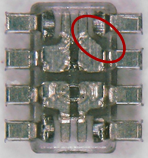SBOS993A December 2021 – December 2022 OPT4001
PRODUCTION DATA
- 1
- 1 Features
- 2 Applications
- 3 Description
- 4 Revision History
- 5 Description (continued)
- 6 Pin Configuration and Functions
- 7 Specifications
- 8 Detailed Description
- 9 Application and Implementation
- 10Device and Documentation Support
- 11Mechanical, Packaging, and Orderable Information
9.5.2.1 Soldering and Handling Recommendations (SOT-5X3 Variant)
The OPT4001 has been qualified for three soldering reflow operations per JEDEC JSTD-020.
Note that excessive heat can discolor the device and affect optical performance.
See application report SLUA271, QFN/SON PCB Attachment, for details on soldering thermal profile and other information. If the OPT4001 must be removed from a PCB, discard the device and do not reattach.
As with most optical devices, handle the device with special care to make sure that optical surfaces stay clean and free from damage. See Section 9.3 for more detailed recommendations. For best optical performance, solder flux and any other possible debris must be cleaned after soldering processes.

 Figure 9-15 Identification Features for
PIN 1 on Package
Figure 9-15 Identification Features for
PIN 1 on Package